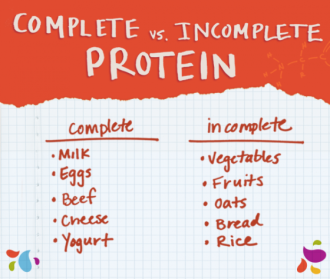By: Nikki Nies
Protein consumption is essential for optimal health, including to build and repair tissues, breakdown food and for nail and skin growth. With the fast speed world we live in, it’s easy to routinely consume fast food and grab dinner with friends than to make a meal at a home.
However, no matter where your next meal is, opt for complete protein meals. What’s a complete protein? Proteins are made up of amino acids, so a protein that contains all essential 9 amino acids–histidine, isoleucine, leucine, lysine, methionine, phenylalanine, threonine, tryptophan, and valine can not be made by the body, but must be obtained from one’s diet.
| Food | Low level of Amino Acids | Complementary Food | Example |
| Nuts and Seeds—peanuts, pecans, walnuts, cashew, almonds, sunflower seeds, sesame seeds | Lysine, isoleucine | Legumes | i.e. lentil—walnut loaf, cashew gravy, fried tofu cubes on mixed salad, peanut coconut dressing |
| Grains: wheat, corn, rice, barley, rye | Lysine, isoleucine, threonine | Legumes, dairy | i.e. grilled cheddar on whole wheat bread; cornbread and chili beans with grated cheese |
| Legumes: lentils, peas, beans | Tryptophan, methionine | Grains, nuts and seeds | i.e. stir fry vegetables with green soybeans, over brown rice, sesame seeds; hummus (chickpeas and tahini spread) served with whole wheat pita bread |
An incomplete protein does not contain all essential amino acids. A complementary protein is when two or more incomplete protein sources that when combined, provide adequate amounts of all the essential amino acids. For example, beans and seeds, beans and nuts, beans and grains, hummus and pita bread, nut butter on whole grain bread, pasta with beans, veggie burgers on bread, split pea soup with whole grain bread, and tortillas with refried beans together can provide sometime with all the essential amino acids
So, how much protein do you need? It’s recommended one consumes 10-35% of their daily caloric intake from protein.
| Recommended Dietary Allowance for Protein | |
|---|---|
| Grams of protein needed each day |
|
| Children ages 1 – 3 | 13 |
| Children ages 4 – 8 | 19 |
| Children ages 9 – 13 | 34 |
| Girls ages 14 – 18 | 46 |
| Boys ages 14 – 18 | 52 |
| Women ages 19 – 70+ | 46 |
| Men ages 19 – 70+ | 56 |
Sources:
https://www.wellowomen.com/blog/2013/02/12/30/complete_vs_incomplete_protein_101
http://althealthworks.com/969/making-a-complete-vegan-protein-five-easy-combinations/
http://www.nlm.nih.gov/medlineplus/ency/article/002222.htm
http://www.fitsugar.com/What-Complete-Protein-Inquiring-Vegetarians-Want-Know-165298





Nice article, thanks! -Nick from http://www.AltHealthWORKS.com
LikeLike